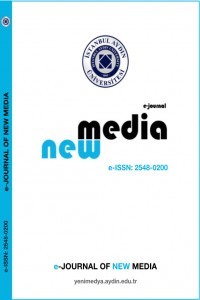DEVELOPING INTERACTIONS IN AUGMENTED MATERIALITY: AN ENHANCEMENT METHOD BASED ON RGB-D SEGMENTATION
augmented reality, perception of reality, occlusion problem, depth camera, segmentation
___
- Aitpayev, K., & Gaber. (2012), J. Creation of 3D human avatar using kinect. Asian Transactions on Fundamentals of Electronics, Communication & Multimedia, 1(5), pp.12-24. Azuma. (1997), R. T. A survey of augmented reality. Presence: Teleoperators & Virtual Environments, 6(4), pp 355-385. Bodnar, J. L., Candoré, J. C., Nicolas, J. L., Szatanik, G., Detalle, V., & Vallet, J. M. (2012) Stimulated infrared thermography applied to help restoring mural paintings. Ndt & E International, 49,pp 40-46. Brooker, J. (2007), The polytechnic ghost: Pepper’s ghost, metempsychosis and the magic lantern at the royal polytechnic institution. Early Popular Visual Culture, 5(2), pp 189-206. Elmorshidy, A. (2010), Holographic Projection Technology: The World is Changing. Journal of Telecommunications, Vol.2 Issue 2. Fischer, J., Bartz, D. (2006), & Straser, W. Enhanced visual realism by incorporating camera image effects. In Proceedings of the 5th IEEE and ACM International Symposium on Mixed and Augmented Reality, October. pp. 205-208. IEEE Computer Society. Henderson, L. D. (1988), X Rays and the Quest for Invisible Reality in the Art of Kupka, Duchamp, and the Cubists. Art Journal Vol. 47, Iss. 4. Hennessey, J. W., & Mitra, N. J. (2015), August. An Image Degradation Model for Depth?augmented Image Editing. In Computer Graphics Forum, Vol. 34, No. 5, pp. 191-199. https://www.youtube.com/watch?v=D0ojxzS1fCw (Retrived 20.08.2015) J.C. Candore, J.L. Bodnar, V. Detalle and P. Grossel. (2012), Non-destructive testing of works of art by stimulated infrared thermography. The European Physical Journal Applied Physics, 57, 21002 doi:10.1051/epjap/2011110266 Kamat, V. R., & Dong, S. (1901), Resolving incorrect visual occlusion in outdoor augmented reality using TOF camera and OpenGL frame buffer. Proceedings of NSF, 2011, pp 1-8. Kamphius, Carolinen, Esther Barsom, Marlies Sschijven, and Noor Christoph. (2014), Augmented Reality In Medical Education?. Perspect Med Educ 3 (4): pp 300-311. Kan, P. & Kaufmann, H. (2012), Physically-Based Depth of Field in Augmented Reality. In Eurographics (Short Papers), pp. 89-92. Kaufmann, Hannes, and Dieter Schmalstieg. (2003), Mathematics and Geometry Education With Collaborative Augmented Reality. Computers & Graphics 27 (3): pp 339-345. Kolmogorov, V., Criminisi, A., Blake, A., Cross, G., & Rother, C, June. (2005), Bi-layer segmentation of binocular stereo video. In Computer Vision and Pattern Recognition. CVPR 2005. IEEE Computer Society Conference, 2005, Vol. 2, pp. 407-414. Kuhn, G., Amlani, Alym A. & Rensink, Ronal A. (2008), Towards a Science of Magic. Trends in Cognitive Sciences 12.9, 349-354 Lepetit, V., & Berger, M. O. (2000), A semi-automatic method for resolving occlusion in augmented reality. In Computer Vision and Pattern Recognition, 2000. Proceedings. IEEE Conference, Vol. 2, pp. 225-230. Lindberg, David C. (2010), Theories of Vision from Al-Kindi to Kepler. University of Chicago Press McGinnis, Jon. Avicenna. (1981), Oxford University Press. Pal G.K., Pal. P. (2001), Textbook of Practical Physiology. Sangam Books Ltd. Ramö, J., & Valimaki, V. (2012), Digital Augmented Reality Audio Headset. Journal of Electrical and Computer Engineering. Rowe, A. (2014), Designing for engagement in mixed reality experiences that combine projection mapping and camera-based interaction. Digital Creativity, 25(2), pp 155-168. Schweitzer, M. (2014), & Zerdy, J. Performing Objects and Theatrical Things. Palgrave Macmillan. Sidharta, R., Hiyama, A., Tanikawa , T., & Hirose, M. (2006), The Development of Multi-Depth Pepper’s Ghost Display for Mixed Reality System. Proceedings of the 16th International Conference on Artificial Reality and Telexistence--Workshops (ICAT'06). Sinthanayothin, C., Wongwaen, N., & Bholsithi, W. (2012), Skeleton Tracking using Kinect Sensor & Displaying in 3D Virtual Scene. International Journal of Advancements in Computing Technology, 4(11). Tsuji, Shigeru. (1990), Brunelleschi and the Camera Obscura: The Discovery of Pictoral Perspective. Art History 13-3: pp 276-292. Ventura, J., & Höllerer, T, August. (2008), Depth compositing for augmented reality. In SIGGRAPH posters, p. 64. Vera, L., Gimeno, J., Coma, I., & Fernandez, M. (2011), Augmented mirror: interactive augmented reality system based on kinect. In Human-Computer Interaction–INTERACT 2011, Springer Berlin Heidelberg, pp. 483-486. Yoh, Myeung-Sook. (2011), The Reality of Virtual Reality. Proceedings of the Seventh International Conference on Virtual Systems and Multimedia (VSMM’01). Yoon, H. C., & Park, J. S. (2013), Avatar animation using skeleton tracking with Kinect sensor. International Journal of Advancements in Computing Technology, 5(12), p.339.
- ISSN: 2548-0200
- Başlangıç: 2017
- Yayıncı: İstanbul Aydın Üniversitesi
SOSYAL MEDYAYLA BİRLİKTE MARKANIN DİJİTALLEŞMESİ
ARTIRILMIŞ GERÇEKLİKLE DEĞİŞEN HABER SUNUMU
Telat YÖNDEM, Gökmen Hakan KARADAĞ
DEVELOPING INTERACTIONS IN AUGMENTED MATERIALITY: AN ENHANCEMENT METHOD BASED ON RGB-D SEGMENTATION
BİR TOPLUMUN AHLAKSAL METAFORU OLARAK SOSYAL MEDYA VE MODERN ZAMANDA AHLAKIN EVRİMLEŞMESİ
VAKIF VE DEVLET ÜNİVERSİTELERİNİN KURUMSAL İMAJ BAĞLAMINDA TWİTTER PAYLAŞIMLARININ İÇERİK ANALİZİ
